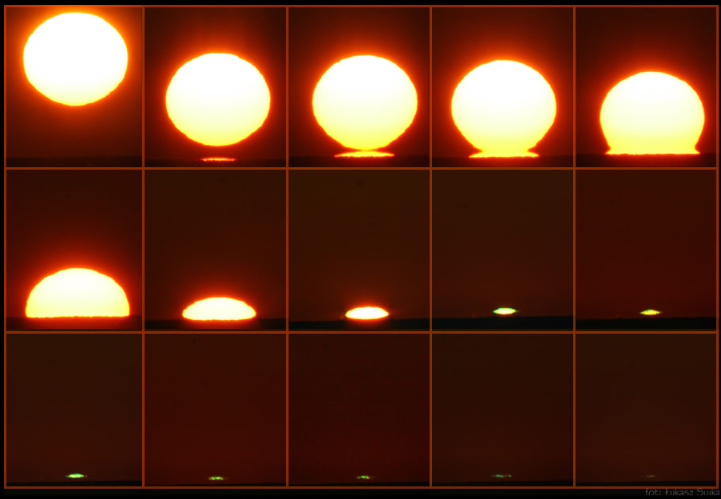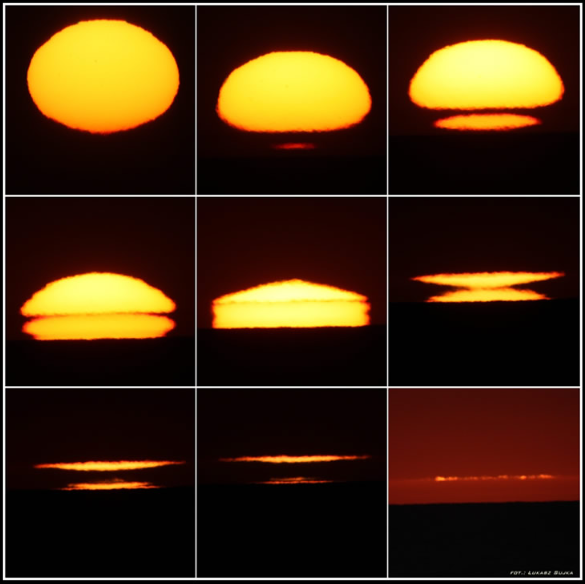Mock-Mirages & Omega Mirages - OPOD
Mock-Mirages & Omega Mirages: A Fascinating Phenomenon in Atmospheric Optics
Have you ever witnessed a mesmerizing sunset where the sinking sun seems to split into bizarre shapes, accompanied by flashes of green or blue above the horizon? These captivating optical phenomena are known as mirages. Within the realm of mirages, there are two main types that add twists to our understanding of these captivating displays: mock-mirages and omega mirages. In this article, we will delve into the intricacies of these mirages and explore the factors that contribute to their formation.
Omega Mirages: When a New Sun Rises from the Horizon
One type of mirage, known as omega mirages, occurs when a new sun appears to rise from the horizon as the upper sun descends. This merging of two suns creates a stunning green flash that can be observed just above the horizon. Lukasz Sujka's images captured over the Baltic from northern Poland beautifully showcase this classical behavior. These omega mirages are produced by the interaction of warm sea-heated air beneath cooler air, which gives rise to this awe-inspiring optical phenomenon.
Mock-Mirages: A Complicated Dance of Sun Slices
In contrast to omega mirages, mock-mirages present a more intricate spectacle. These mirages feature several sun slices that appear to rise and descend simultaneously, accompanied by faint and transient green flashes above the horizon. While they may be less easily visible to the naked eye, mock-mirages can be captured through photography. However, it is important to note that attempting to observe them while the sun is still above the horizon can be dangerous.
Unraveling the Mysteries: The Role of Temperature Inversions
To understand the formation of both mock-mirages and omega mirages, we must consider the role of temperature inversions. Temperature inversions occur when a layer of warm air is trapped beneath a layer of cooler air. These inversions act as the catalyst for the creation of these atmospheric wonders. One or more temperature inversions generate mock-mirages, while the interaction between warm sea-heated air and cooler air gives rise to omega mirages.
The Beauty and Complexity of Atmospheric Optics
The captivating nature of mock-mirages and omega mirages exemplifies the intricacies of atmospheric optics. These optical phenomena remind us that nature often defies our attempts at classification and simplicity. By exploring and studying these phenomena, scientists gain valuable insights into the behavior of light and the atmospheric conditions that contribute to their formation.
Capturing the Magic: Lukasz Sujka's Stunning Images
Renowned photographer Lukasz Sujka has provided us with a visual feast of mock-mirages and omega mirages through his stunning images captured over the Baltic from northern Poland. His photographs beautifully showcase the mesmerizing shapes and vibrant flashes of green and blue that accompany these atmospheric phenomena. Through Lukasz's lens, we are able to witness the awe-inspiring beauty of these mirages and appreciate the intricate dance of light in the sky.
A Reminder of Nature's Complexity
Mock-mirages and omega mirages serve as a reminder that the natural world is full of complexity and wonders waiting to be discovered. These atmospheric optical phenomena challenge our understanding of light and atmospheric conditions, encouraging scientists and enthusiasts alike to delve deeper into the mysteries of the sky. By studying these mirages, we gain a greater appreciation for the beauty and intricacy of our natural surroundings.
In conclusion, mock-mirages and omega mirages are captivating optical phenomena that add an element of intrigue to our understanding of atmospheric optics. These mirages, with their mesmerizing shapes and flashes of color, demonstrate the complexity of nature's interplay with light and atmospheric conditions. Through the lens of talented photographers like Lukasz Sujka, we are able to witness the magic of these mirages and gain a deeper appreciation for the beauty that surrounds us in the sky. So, keep your eyes peeled and be ready to marvel at the wonders of atmospheric optics that await you during your next sunset adventure.

Mirages & Mirages
Sets of sunset images taken over the Baltic from northern Poland by Lukasz Sujka.
Mirages have split the sinking sun into weird shapes. Several green flashes show above the horizon and finally close to the sea itself.
Green or blue flashes and sunset mirages come in several guises. There are are two main types – ‘mock-mirages’ and ‘omega mirages’. Here both mix to show that Nature adds twists to our attempts at classification and simplicity. See animation.
Omega sunsets or mirages are where a new sun rises from the horizon as the upper sun descends. The two merge to a green flash almost on the horizon. Lukasz’s second set of images (below) taken a month earlier show this classical behaviour. Warm sea heated air beneath cooler air produces them.
Mock mirages are more complicated. Several sun slices rise and descend simultaneously. The green flashes are above the horizon. They are faint and transient. They show up in photographs but are less easily seen visually. It’s dangerous to look for them as the sun is still above the horizon. One or more temperature inversions generate mock-mirages.
All images ©Lukasz Sujka, shown with permission

A classical 'Omega' or 'Etruscan vase' miraged sunset with a final green flash just above the horizon

A mock-mirage sunset taken a day after the topmost set of images.
Note: this article has been automatically converted from the old site and may not appear as intended. You can find the original article here.
Reference Atmospheric Optics
If you use any of the definitions, information, or data presented on Atmospheric Optics, please copy the link or reference below to properly credit us as the reference source. Thank you!
-
<a href="https://atoptics.co.uk/blog/mock-mirages-omega-mirages-opod/">Mock-Mirages & Omega Mirages - OPOD</a>
-
"Mock-Mirages & Omega Mirages - OPOD". Atmospheric Optics. Accessed on November 26, 2024. https://atoptics.co.uk/blog/mock-mirages-omega-mirages-opod/.
-
"Mock-Mirages & Omega Mirages - OPOD". Atmospheric Optics, https://atoptics.co.uk/blog/mock-mirages-omega-mirages-opod/. Accessed 26 November, 2024
-
Mock-Mirages & Omega Mirages - OPOD. Atmospheric Optics. Retrieved from https://atoptics.co.uk/blog/mock-mirages-omega-mirages-opod/.